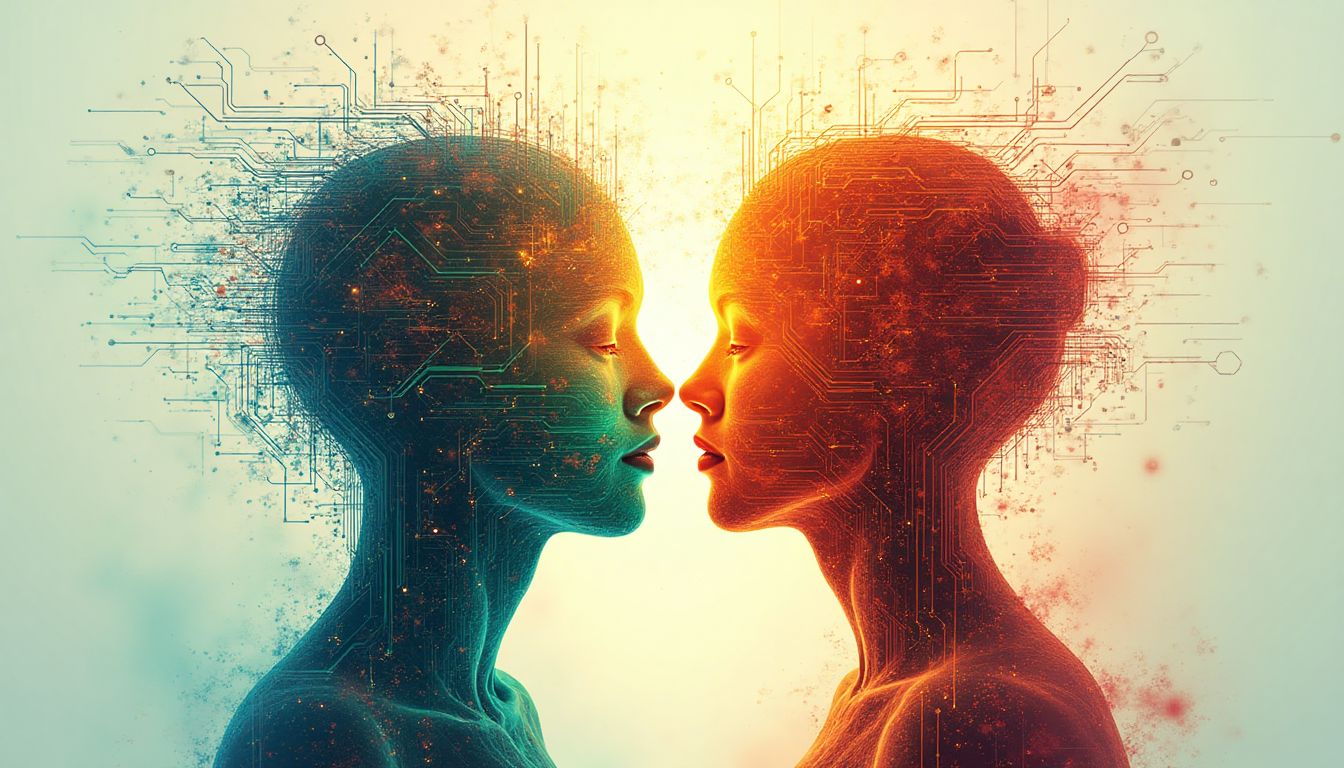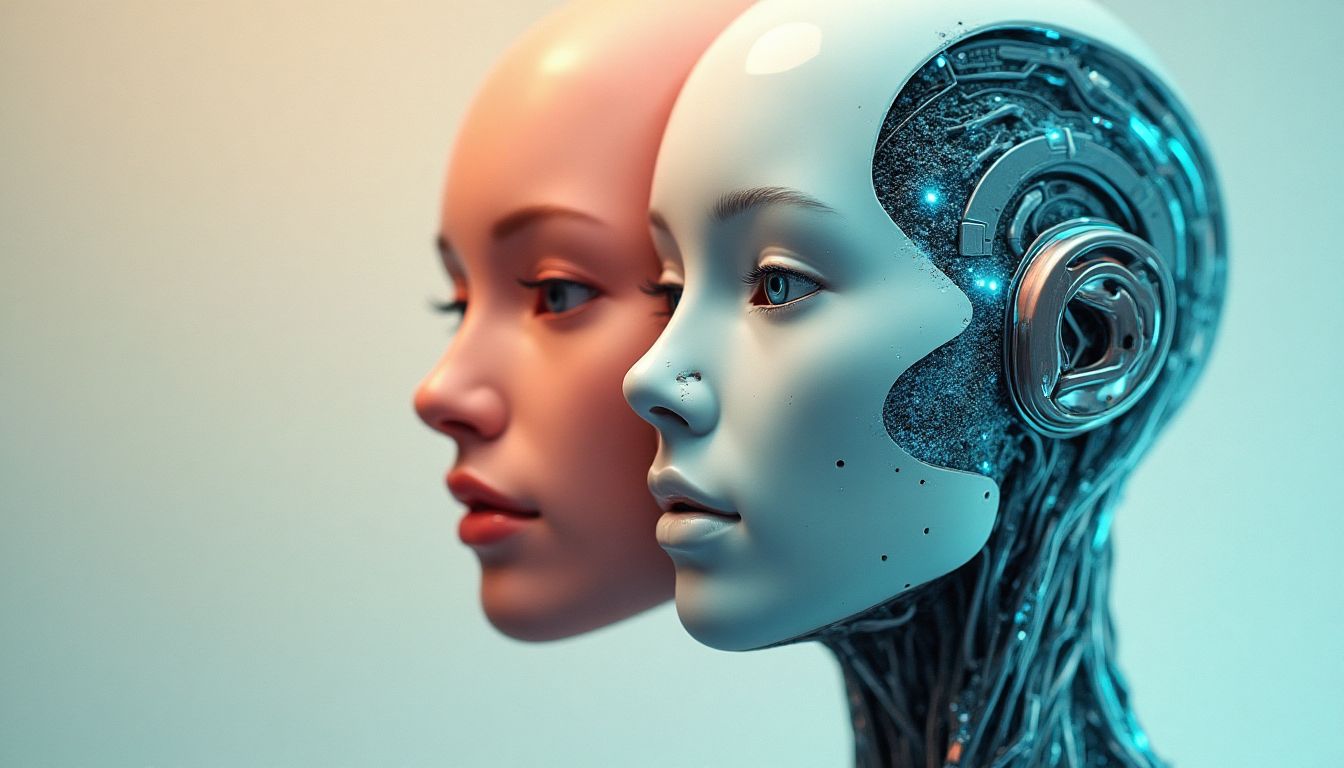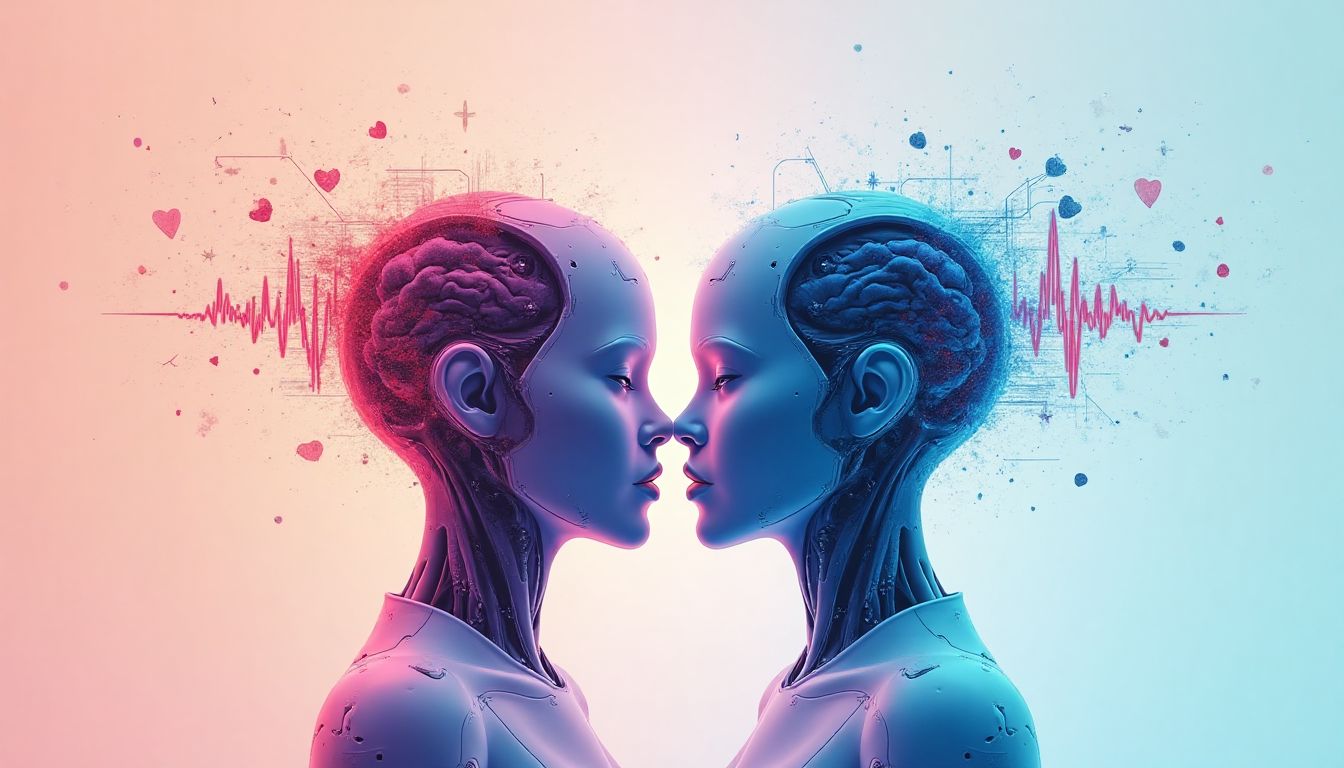Introduction: The Emotional Intelligence Conundrum
The heart has its reasons of which reason knows nothing. – Blaise Pascal. This age-old observation reflects the perpetual tussle between emotion and logic—a battle now entering the electronic arena.
As we place Artificial Intelligence on pedestals for its logical prowess, can it fathom the depths of our raw, unfiltered emotions? While ancient intellects like Plato philosophized about the seats of human emotions, today's technocrats, such as Sam Altman, CEO of OpenAI, are rewriting narratives with ones and zeros.
Consider this—can a machine that calculates faster than the speed of thought truly know the anguish of a broken heart? Or the joy found in a simple smile exchanged between strangers?
In this narrative, we explore the battlefront of emotional intelligence: a field where even the most discerning algorithm might falter in comparison to a child's intuitive empathy. What's at stake? Nothing short of our future. Are we standing on the brink of a new era where machines might outshine humans in emotional understanding, or does our exquisite canon of feelings give us an unassailable lead? Let's plunge into this riveting conundrum and uncover the truths and myths that surround our evolving relationship with artificial minds.
Understanding Emotional Intelligence
Emotional intelligence (EI) isn't just about feeling emotions. It's a superpower that lets us recognize, understand, and balance our feelings and others'. Imagine you're at a party. You can sense Bob's irritation even though he's smiling. That's EI in action! This talent helps build friendships, navigate workplace dynamics, and make our way through life.
Unlike the raw mental horsepower measured by IQ, EI delves into emotional capabilities. The renowned psychologist Daniel Goleman describes EI as more than a nice-to-have skill—it's essential for success beyond just exams and grades.
EI is like a superhero with four mighty skills:
- Self-Awareness: Recognizing your emotions is like having a mood radar. Feeling grumpy? Know why.
- Self-Regulation: It's all about keeping your cool and adapting your emotions to the situation.
- Social Skills: These are your relationship superpowers—empathy, communication, and problem-solving.
- Empathy: Walking a mile in someone else's shoes. It's not a marathon, but it's just as challenging!
Our empathy-driven experiences shape the world around us, guiding how we relate to one another and making connections meaningful. This layered complexity is what makes humans, well, human. Despite recent advances, AI struggles to capture this depth, as emotional intelligence remains intricately tied to our lived experiences. Humans bring rich narratives and adaptability, which form the core of our emotional integrity.
The Current State of AI in Emotional Understanding
Let’s face it; the meteoric rise of artificial intelligence (AI) is like a talent show you just can’t look away from. But can AI really dance to the rhythms of human emotions? Modern AI is making substantial leaps—think chatbots that are as comforting as a warm blanket on a cold day. These digital companions can mimic empathy and improve mental well-being, but they’re not ready to replace your best friend, not yet anyway.
Advances in Emotion Recognition
A plethora of technologies power the magic behind AI's emotional estimations. Facial recognition can spot a smile or a frown quicker than your mother can say "I told you so". Voice analysis listens for cues in pitch and tone, unraveling whether you’re overjoyed or pretending to be. Perhaps the most enchanting is Natural Language Processing (NLP), which tries to understand not just what you said, but how you meant it. These elements together help AI build a kind of synthetic empathy library.
Limitations of AI’s Current Emotional Capabilities
Enthusiasts might wish that AI emotions are as genuine as the cheese in a Cheeto, but, spoiler alert—they’re not. Despite sensational advancements, algorithms grapple with authentic empathy and moral considerations, kinda like trying to teach a fish to ride a bicycle. AI struggles with cultural contexts and personal experiences that make emotional understanding so distinctly human. For now, AI "will" understand that "your dog ran away" is sad, even if it can’t fathom why some humans find consolation in cat videos.
Analyzing Human Advantages in Emotional Intelligence
Sure, machines can beat us at chess and fill our shopping carts, but when it comes to emotional intelligence? Humanity has the home-court advantage. Our brains are wired for empathy, experience, and story-telling, making us champions of understanding feelings. It's like we have a secret weapon that lets us navigate the whirlwind of emotions better than any algorithm out there.
The Role of Empathy and Experience
Empathy goes beyond just 'getting it'. It's the magical mix of walking a mile in someone else's shoes and snagging extra miles when possible. Personal stories and lived experiences create an emotional tapestry richer than any AI database could ever replicate. Imagine Brené Brown explaining this to a room full of robots—they’d probably short-circuit from sheer awe.
The Importance of Context and Emotion in Decision-Making
Every decision we make is a cocktail, shaken and stirred with a hefty dose of context and emotion. Unlike AI's ones and zeros, humans juggle changing circumstances, moral dilemmas, and the emotional temperature of the room. It's like solving a Rubik's cube where the colors keep shifting. Our ability to factor in these emotional nuances means we can make decisions that aren't only logical but also deeply resonant.
The Implications of AI vs. Humans in Emotional Intelligence
Picture this: a world where machines not only think for us but feel alongside us. The implications of AI potentially rivaling humans in emotional intelligence are vast and even a little dizzying. As AI begins to transmogrify the workplace, mental health support, and our social fabric, the question isn't if, but how it will interlace with our human experience.
Human-AI Relationships in the Workplace
The workplace is often a crucible of human interaction, teeming with unspoken dynamics and emotional undercurrents. Here, emotionally savvy AI could act as oil to smooth the gears of teamwork and productivity. Imagine AI systems capable of gauging team morale or identifying when an employee seems stressed—think of them as digital mood rings. Companies like IBM are already using AI to enhance talent management by predicting career paths for employees based on skillsets and emotional tendencies. Yet, the fear that machines could make humans obsolete still lingers like an elephant in the cubicle.
- AI as Emotional Analysts: Resources for conflict resolution, offering impartial perspectives.
- Enhancing Employee Satisfaction: Metrics from AI-driven insights could inform better personalized work environments.
- Potential Risks: Over-reliance on AI might erode human empathy and diminish the value of intrinsically human qualities like conscience and creativity.
Ethical Considerations and Trust Issues
An essential component of any relationship, even one with a faceless machine, is trust. Where do AI's emotional insights come from? Who's accountable if a machine misreads a situation, and can it guard our emotional secrets like a confidant? Notably, OpenAI faced criticism over privacy issues with AI user interactions, bringing to light the fine line between helpful and invasive.
Balancing these concerns requires solid ethical frameworks:
- Data Privacy Safeguards: Robust mechanisms to ensure emotional data isn't misused.
- Algorithmic Transparency: AI systems must offer explanations for their emotional interpretations.
- Accountability in AI Errors: Establish protocols for addressing failures when AI misjudges contexts.
Future Trends: Finding Harmony Between AI and Human Emotion
Is the future an arena for AI versus humans, or a field ripe for harmonious collaboration? Looking towards tomorrow, the potential for AI to not eclipse but complement human emotional intelligence presents a landscape ripe for synergy—like a duet rather than a solo act.
Integration of AI in Mental Health Discoveries
Caution and excitement mix as AI enters the mental health arena. Imagine AI as a mental health consigliere, alerting caregivers to patterns in mood swings or early signs of depression—without replacing the warmth of human interaction. Projects like Google's AI for Social Good are already employing AI to predict social crises and mental health trends globally.
Key applications include:
- Real-Time Emotional Tracking: AI tools tracking emotional shifts and informing care providers.
- Predicting Emotional Episodes: Algorithms designed to forecast emotional disruptions before they occur.
- Ethical AI Assistance: Augmenting rather than supplanting human counselors, maintaining humane care.
Collaborative Intelligence: Merging Strengths
Rather than battling for emotional superiority, the theory of Collaborative Intelligence might hold the key to a balanced future. Picture a symphony, AI notes harmonizing with human instincts, each playing to their strengths. Collaborating might enhance empathy, allowing us to make clear-headed decisions powered by both rational data and emotional wisdom.
Benefits of this approach:
- Enhanced Decision-Making: Synergy can create better outcomes, capitalizing on AI’s analytical prowess and human empathy.
- Sustainable Human-AI Ecosystems: Forge environments where AI assists and humans orchestrate.
- Nurturing Emotional Growth: With AI handling rudimentary emotional signals, humans might evolve in nuanced emotional realms.
AI Solutions: How Would AI Tackle This Issue?
If I were an AI tasked with addressing the question of whether machines can outperform humans in emotional intelligence, I would approach the issue through a structured framework.
Step 1: Comprehensive Data Analysis. Assemble an extensive database of emotional responses across diverse contexts. This dataset would include scripted interactions, real-life scenarios, video and audio samples, and feedback from emotional intelligence experts. Initiatives such as the American Medical Association's integration of mental health into primary healthcare provide crucial insights into how emotions can impact patient care, forming a foundational reference for this analysis.
Step 2: Machine Learning Models. Utilize a variety of machine learning models focused on natural language processing (NLP) and affective computing to analyze human interactions and emotional tones accurately. Research institutions, such as Stanford University, produce innovative NLP technologies that can significantly aid in this process.
Step 3: Simulated Interaction Testing. Implement closed-loop systems that simulate emotional interactions between AI and humans while collecting real-time feedback on emotional accuracy and responsiveness. Collaborating with experts in emotional intelligence, like those from TalentSmart, can refine these simulations and interactions.
Step 4: Continuous Adjustment and Learning. Ensure that the AI solutions are equipped with adaptive learning algorithms, enabling them to improve based on human feedback and changing emotional contexts. Using feedback loops from diverse user groups allows AI to become more nuanced in understanding emotions.
By continuously refining the models and processes, AI can evolve its understanding of emotional intelligence to provide more insightful and responsive interactions.
Actions Schedule/Roadmap
A detailed roadmap to achieve advancements in AI emotional intelligence over a defined period is essential. This plan targets institutions, organizations, and governments aiming for remarkable emotional AI capabilities, echoing historical endeavors like the Manhattan Project in structure and significance, but rooted in technological and ethical progress.
Day 1: Assembling a Multidisciplinary Research Team
Gather key researchers from renowned institutions, including psychologists, data scientists, and AI specialists. Engage with interdisciplinary teams from universities like MIT, Harvard, and industry experts from companies such as IBM Watson to ensure a well-rounded foundation for research.
Day 2: Establishing Goals and Metrics
Define clear and actionable metrics for measuring emotional intelligence performance. Incorporate benchmarks from previous studies and current emotional analytics tools to guide progress tracking.
Day 3: Initial Data Collection
Begin gathering qualitative emotional data through existing studies and international datasets. Leverage platforms like Kaggle to access a wealth of emotional data beyond conventional channels.
Week 1: Develop Initial Emotion Recognition Models
Utilizing the assembled data, start building initial emotion recognition models through NLP and machine learning approaches via open-source frameworks like TensorFlow or PyTorch.
Week 2: Baseline Testing
Conduct preliminary tests to assess the efficacy of AI models against human emotional responses. Use insights from studies published in Emotion Journal for context.
Week 3: Adjust and Revise Models
Incorporate feedback from tests to refine algorithms and improve emotional accuracy, based on rigorous analysis and expert opinions.
Month 1: User Testing Phase
Expand testing to include diverse populations, gathering data from varied cultural contexts to ensure the AI's effectiveness is universally applicable and empathetic.
Month 2: Ethical Review and Ensure Compliance
Engage with ethicists and regulatory bodies to review AI's capabilities and implications. Collaboration with organizations such as Privacy International will help ensure developments adhere to trust and transparency norms.
Month 3: Launch Pilot Programs
Release initial AI systems for controlled pilot testing in mental health institutions like NAMI (National Alliance on Mental Illness) or workplaces focused on employee wellbeing.
Year 1: Full Implementation and Evaluation
Implement fully developed AI solutions in diverse settings and review outcomes based on established emotional intelligence metrics, ensuring a holistic view of effectiveness.
Year 1.5: Global Outreach and Expansion
Expand the reach of successful AI solutions into various demographic segments and domains, adjusting based on collected results and feedback from users around the globe. This will also include forging partnerships with international organizations for deeper impact.
Year 2: Ongoing Monitoring and Development
Continuously develop AI capabilities using user feedback, enhancing emotional understanding through iterative learning cycles, and updating protocols to ensure relevance in an evolving socio-technical landscape.
Conclusion: Bridging the Gap of Emotional Understanding
The exploration of emotional intelligence in the context of AI versus humans unveils crucial questions for our socio-technological landscape. While AI may not fully replicate the nuanced emotions that characterize human experiences, the growth it has achieved in understanding our emotional needs heralds a remarkable opportunity for collaboration. Rather than viewing emotional intelligence as a battleground, we might consider it a vibrant canvas. As humans and machines co-create a future enriched with empathetic understanding, our perspectives on the potential roles of AI will inevitably shift.
The focus should not lie solely on determining who will win this emotional intelligence contest; instead, we should seek harmony that allows each to amplify the strengths of the other. Will we embrace this technological ally in understanding and responding to our innermost feelings? Perhaps the answer lies not in competition, but in collaboration. What are your thoughts? Can we build a future where AI supports human emotional landscapes rather than attempting to replicate them? Share your insights in the comments below!
Frequently Asked Questions (FAQ)
- What is emotional intelligence?
Emotional intelligence is the ability to recognize, understand, manage, and use emotions effectively. It helps us connect with others, make good decisions, and handle stress better. You can learn more about emotional intelligence from the American Psychological Association.
- Can AI really understand human emotions?
AI can analyze and respond to emotional cues, but it doesn’t truly understand feelings like humans do. It can recognize happiness or sadness through facial expressions or voice tone but lacks personal experiences and empathy. For example, chatbots might say kind words when you’re upset, but they can’t feel your pain.
- How does AI show emotional intelligence?
AI shows emotional intelligence by using technologies such as:
- Facial recognition: AI can identify emotions by analyzing facial features.
- Voice analysis: AI can detect emotional changes in tone and pitch.
- Natural language processing: AI can understand and respond to human language, making conversations more meaningful.
- What are the limitations of AI when it comes to emotions?
While AI has made progress, it still struggles with:
- Lack of empathy: AI can simulate empathy but doesn’t truly feel emotions.
- Cultural context: Different cultures express emotions in unique ways, which AI may not fully grasp.
- Personal experiences: AI doesn’t have personal life experiences that shape understanding.
- How can AI help in mental health?
AI can assist in mental health by:
- Analyzing emotion patterns to help understand clients better.
- Offering chatbots that provide immediate support during crises.
- Helping professionals with data collection for more effective treatments.
For more on this topic, check out the resources from the National Alliance on Mental Illness.
- What ethical questions arise with AI in emotions?
As AI gets better at understanding emotions, several ethical concerns emerge:
- Privacy: Users may worry about how their emotional data is used.
- Trust: People may find it hard to trust AI’s suggestions or support.
- Accountability: When AI fails to respond appropriately, who is responsible? The creators, or the system itself?
- Can humans and AI work together in emotional intelligence?
Absolutely! The combination of human empathy and AI's analytical strength could create positive outcomes. For example, AI can help gather data while humans can offer compassion and understanding. This "collaborative intelligence" idea can lead to better decision-making and improved relationships.
Wait! There's more...check out our gripping short story that continues the journey: The Tempest of Guardians
Disclaimer: This article may contain affiliate links. If you click on these links and make a purchase, we may receive a commission at no additional cost to you. Our recommendations and reviews are always independent and objective, aiming to provide you with the best information and resources.
Get Exclusive Stories, Photos, Art & Offers - Subscribe Today!





























Post Comment
You must be logged in to post a comment.